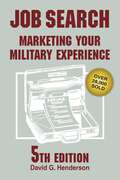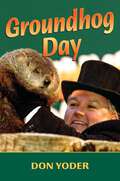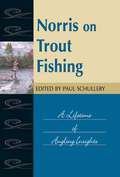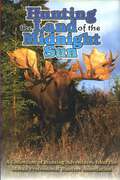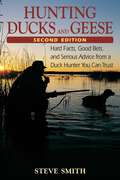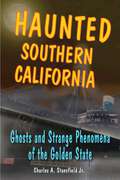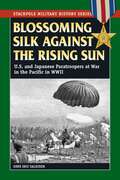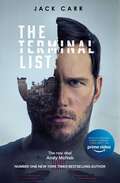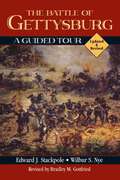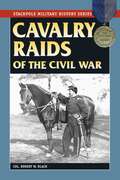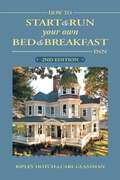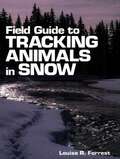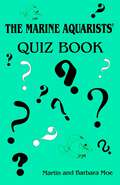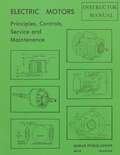- Table View
- List View
Job Search
by David G. HendersonComprehensive, popular guide to a successful job search. More than 40 examples of successful resumes.
Groundhog Day
by Don YoderFrom the Pennsylvania Dutch Country in Southeastern and Central Pennsylvania has spread the fun holiday celebration of Groundhog Day. Now firmly ensconced as a national event every February 2, it radiates outward from Punxsutawney, Pennsylvania and gives us all a welcome holiday to celebrate between New Year&’s Day and Easter. Through this holiday, the Groundhog has in a sense been personalized and humanized. Learn more about this unique holiday and grab your copy of Groundhog Day today!
Complete Book of Tanning Skins & Furs
by James ChurchillIn the classic reference, learn techniques of tanning with background information on the necessary tools and equipment.
Norris on Trout Fishing (Fly Fishing Classics)
by Paul Schullery• Excerpts American Angler's Book, the foremost fishing reference book of its time• Info on native fishes of North America• Technical expertise on tackleNorris on Trout Fishing samples both the expertise and the generous warmth that made Thaddeus Norris (1811-1877) such a beloved figure in American angling. From his wise portrayal of the many types of anglers, to the biology and behavior of native American brook trout, to his touching portrait of the now-extinct Michigan grayling, Norris set a standard for American angling thought that educated and inspired succeeding generations and still offers us both provocation and wisdom today. His concluding essay on the joys of fly fishing alone is regarded as a primary milestone of angling philosophy that set the tone for the philosophical explorations of many later writers from Arnold Gingrich to Ernest Schwiebert to John Gierach.
Hunting Land Midnight Sun Ltd: A Collection of Hunting Adventures from the Alaska Professional Hunters' Association
by APHAHunting the Land of the Midnight Sun contains 37 stories from dozen of members of the famous Alaska Professional Hunters Association
Hunting Ducks and Geese
by Steve SmithCovers preseason scouting, how and where to place a blind, use of decoys and calls. Identifies and corrects common mistakes made when placing and setting up blinds and decoys, timing the hunt, and waiting for waterfowl.
Haunted Southern California (Haunted Series)
by Charles A. StansfieldIs there a shadow over this sunny land of healthful vigor and natural abundance? This region includes the Central Coast, the San Joaquin Valley, and metropolitan Los Angeles and San Diego, where readers will encounter the spirits of gold prospectors, cowboys, Spanish padres, and movie stars, as well as the phantom camels of Fort Tejon, the shape-shifting witch of Tulare, underwater UFOs, ghosts aboard the Queen Mary, and the tragic specter of Marilyn Monroe.
Blossoming Silk Against the Rising Sun (Stackpole Military History Series)
by Gene Eric SaleckerComplete account of airborne operations in the Pacific theater. Firsthand descriptions from American and Japanese paratroopers. Detailed maps illustrate battles.
The Terminal List: James Reece 1 (Terminal List Ser. #1)
by Jack CarrNow an original series starring Chris Pratt and the inspiration for the series The Terminal List: Dark Wolf now streaming on Prime Video. &“Take my word for it, James Reece is one rowdy motherf***er. Get ready!&”—Chris Pratt, all around great guy and star of the #1 Amazon Prime series The Terminal List A Navy SEAL has nothing left to live for and everything to kill for after he discovers that the American government is behind the deaths of his team in this ripped-from-the-headlines political thriller that is &“so powerful, so pulse-pounding, so well-written—rarely do you read a debut novel this damn good&” (Brad Thor, #1 New York Times bestselling author). Now an original series starring Chris Pratt on Prime Video.On his last combat deployment, Lieutenant Commander James Reece&’s entire team was killed in a catastrophic ambush. But when those dearest to him are murdered on the day of his homecoming, Reece discovers that this was not an act of war by a foreign enemy but a conspiracy that runs to the highest levels of government. Now, with no family and free from the military&’s command structure, Reece applies the lessons that he&’s learned in over a decade of constant warfare toward avenging the deaths of his family and teammates. With breathless pacing and relentless suspense, Reece ruthlessly targets his enemies in the upper echelons of power without regard for the laws of combat or the rule of law. &“Told with a deft hand and a keen eye for detail, The Terminal List…is explosive and riveting&” (Kevin Maurer, co-author of No East Day) and is perfect for fans of Vince Flynn, Brad Thor, Stephen Hunter, and Nelson DeMille.
Battle of Gettysburg
by Edward J. Stackpole Wilbur S. NyeFully revised and updated version of the 1960 classic. A must for Civil War buffs, amateur and professional alike.
Cavalry Raids of the Civil War (Stackpole Military History Series)
by Robert W. BlackCovers raids from J. E. B. Stuart's 1862 ride around McClellan's army to James Wilson's crashing raids in Alabama and Georgia in 1865.
How to Start & Run Your Own Bed & Breakfast Inn
by Carl Glassman Ripley Hotch• All the knowledge needed for running a profitable business• Revised and updated with new information on computers, the Internet, and cell phonesExperienced and first-time innkeepers need reliable information to help them meet the challenges of running a successful inn. This book reveals the secrets of the best inns, including information on securing financing, buying and managing the inn, attracting the right guests, developing a business plan, addressing legal and insurance needs, marketing the inn effectively, and locating professional organizations.
In the Fire of the Eastern Front (Stackpole Military History Series)
by Hendrick C. VertonExtraordinary story of a Dutch volunteer in the Waffen-SS. Vivid details on SS training and combat on the Eastern Front. Account of the little-known siege of Breslau in early 1945.
Never Quit The Fight
by Ralph PetersDrawing on his global experiences from Africa to Iraq, author Ralph Peters attacks today's crucial issues of our time head-on, with the clear eye and blunt voice that has won him a devoted following: • Is Iraq worth it? What's the truth behind the politics? • Are our defense dollars buying a strong military--or the wrong military? • Are we missing great opportunities elsewhere while hypnotized by the Middle East? • Must we accept that Islam itself is the problem? • Will we face a war with China? What would such a war mean? • Can Washington learn from its mistakes? These are just a few of the controversial issues Peters takes on in a series of body blows to the status quo. Famed as the most original strategist of our time, Ralph Peters builds on the critical and commercial success of previous books, Wars of Blood and Faith (978-0-8117-0274-4) and New Glory (1-59523-011-4), to offer a stunningly fresh vision for our military, our country, and the world.
Field Guide to Tracking Animals in Snow
by Denise Casey Louise R. ForrestFocuses on the animal's track pattern, making windblown and obscured tracks identifiable.
Marine Aquarists' Quiz Book
by Barbara Moe Martin A. MoeMartin and Barbara Moe have created the ultimate marine aquarium quiz book. There are 400 questions: each has four possible answers that test your knowledge, tease your brain, and tickle your funny bone. The correct answers are on the reverse of each question page and they are loaded with information on marine fish, marine invertebrates, marine aquaristics, reef and sea - answers that teach you a lot about this fascinating hobby. Although there isn't a million dollar prize, you could use this book to play "Who wants to be a Marine Biologist" or "Marine Aquarists trivia". Whether it is read as a source of information on the hobby or used as an entertaining exercise, it will leave you with a greater understanding of the reef, the sea, and the captive marine environment.
Radical Bear Hunter
by Dick ScorzafavaRadical strategies for hunting the elusive and challenging black bear. Detailed guide to bear biology and population information, including where to find monster bears and color-phase bears. Essential bear country tips, including staying safe, field-judging trophy bears, and reading bear body language along with a complete rundown of North American bear hunting hotspots.
Haunted Kentucky (Haunted Series)
by Alan BrownKentucky's beauty is offset by a violent past of Indian wars, Civil War battles, and the tragic spirits from these conflicts.
Beyond the Beachhead: The 29th Infantry Division in Normandy (Stackpole Military History Series)
by Joseph BalkoskiExpanded edition with a new chapter on the final battles of the Normandy campaign.
Electric Motors Principles, Controls, Service, & Maintenance Instructor's Guide
by Forrest W. BearThis manual has been prepared for teachers and students in Vocational Agriculture and Industrial Education, at the secondary and post secondary levels. An educator can utilize this text for study of the fundamentals of electricity, generation of electricity, motor principles, overload protection devices, switches and sensing divices for controlling motors, wiring of circuits, testing of motors and essential service and maintenance. There are also classroom and laboratory exercises which reinforce the technical subject matter in each unit. ,
The True Story of Saint Nicholas
by Rebecca Benson HaskellYes, there is a Saint Nicholas. A generous man and a bishopof the early Christian Church, he performed miracles. Today he is a patron saint to young people, sailors, and even prisoners. In this thoughtfully written book for parents and their children, Rebecca Benson Haskell, a great-grandmother from Marblehead, Massachusetts, tells the true story of the man we know as Santa Claus.
True Crime: New York City (True Crime)
by Bryan Ethier• Introduction to crime in the city • Headline cases In New York City, crime is big--big in newspaper headlines, big to politicians who win and lose jobs because of a flux in crime, and big in the lore of the city itself. This book begins with a survey of crime in the Big Apple and then focuses on its landmark cases, including the sixteen-year terrorism of the Mad Bomber, the bystander effect in the fatal stabbing of Kitty Genovese, the Son of Sam serial killings, the assassination of John Lennon, the fall of mob boss Paul Castellano, and the murder of Jennifer Levin by Preppie Killer Robert Chambers Jr.
Rommel's Desert War (Stackpole Military History Series)
by Samuel W. Mitcham Jr.The most famous battles of one of World War II's most legendary commanders. Told largely from Rommel's perspective, using his papers and letters.
Panzer Commanders of the Western Front (Stackpole Military History Series)
by Samuel W. Mitcham Jr.Detailed biographies of 5 panzer commanders. Describes what it's like to lead tank units in battle. Includes D-Day, Normandy, the campaign for France, the Battle of the Bulge, and the final battles in Germany.
Fall & Winter Turkey Hunter's Handbook
by Steve HitkoffScouting specifics for the 40+ states that offer fall and winter turkey hunting seasonsTactics for approaching landowners and securing permission to hunt private land plus strategies for firearms, bowhunting, and hunting turkeys with dogsInsights on turkey vocalizations, calling birds, locating fall and winter roosts, and patterning flocksFor the sportsman who thrills at the booming gobble of a spring tom during mating season and wants to extend that exhilarating feeling, Steve Hickoff's Fall and Winter Turkey Hunter's Handbook offers the perfect remedy. Hickoff examines fall turkey behavior and vocalizations and provides details on locating, scouting, and calling fall gobblers, with tips for mapping flock patterns and identifying changing flock composition. Also discussed is the little-known strategy of hunting turkeys with dogs, using them to find and flush flocks. The material on firearms, ammunition, and archery tackle will benefit all turkey hunters--fall, winter, or spring.
